Dynamics CRM 2016 is the current version of the popular Customer Relationship Management platform offered by Microsoft. This platform offers users the ability to integrate and connect data across their sales, marketing, and customer service activities, and to give staff an overall 360-degree view of all interactions and activities as they relate to a specific customer.
Along with the standard platform functionality provided, we have a wide range of customization options, allowing us to extend and further customize solutions to solve a majority of other business requirements. In addition, we can integrate this platform with other applications to create a seamless solution.
Being the only available CRM platform on the market today, Microsoft Dynamics CRM 2016 is one of the fastest growing, gaining large acceptance at all levels, from small to mid-size and enterprise-level organizations. This is due to a multitude of reasons, some of which include the variety of deployment options, the scalability, the extensibility, the ease of integration with other systems, and the ease of use.
Microsoft Dynamics CRM can be deployed in a variety of options. Starting with the offering from Microsoft, you can get CRM Online. Once we have a 30-day trial active, this can be easily turned into a full production environment by providing payment information and keeping the environment active. The data will live in the cloud, on one of the data centers provided by Microsoft.
Alternatively, you can obtain hosting with a third-party provider. The whole environment can be hosted by a third party, and the service can be offered either as a SaaS solution or a fully hosted environment. Usually, there is a difference in the way payment is processed, with a SaaS solution, in most cases, being offered in a monthly subscription model.
Another option is to have the environment hosted in-house. This option is called on-premise deployment and carries the highest up-front cost but gives you the ability to customize the system extensively. In addition to the higher up-front cost, the cost to maintain the environment, the hardware, and the skilled people required to constantly administer the environment can easily add-up.
As of recently, we now have the ability to host a virtual CRM environment in Azure. This offloads the cost of maintaining the local infrastructure in a fashion similar to a third-party-hosted solution but takes advantage of the scalability and performance of a large cloud solution maintained and supported fully by Microsoft. The following white paper released by Microsoft describes the deployment model using Azure Virtual Machines:
http://www.microsoft.com/en-us/download/details.aspx?id=49193
Some of the most notable features of the Dynamics CRM platform include:
Scalability
Extensibility
Ability to integrate with other systems
Ease of use
Let's look at each of the features in more detail.
Dynamics CRM can scale over a wide range of deployment options. From a single-box deployment, used mostly for development, all the way to a cloud offering that can span over a large number of servers, and can host a large number of environments, the same base solution can handle all the scenarios in between with ease.
Dynamics CRM is a platform in which the base offering comes with prepackaged functionality for sales, service, and marketing; and a large variety of solutions can be built on top of Dynamics CRM. The extensibility model is called xRM and allows power users, non-developers, and developers alike to build custom solutions to handle various other business scenarios or integrate with other third-party platforms.
The Dynamics CRM Marketplace is a great example of such solutions built to extend the core platform, and offered for sale by various companies. These companies are called Independent Software Vendors (ISVs) and play a very important role in the ecosystem created by Microsoft. In time and with enough experience, some of them become the go-to partners for various implementations.
If nothing else, the Dynamics Marketplace is a cool place to look at some of the solutions created and search for specific applications. The idea of the marketplace became public sometime around 2010 and was integrated into Dynamics CRM 2011. At launch, it was designed as a searchable repository of solutions. It is a win-win for both solution providers and customers alike. Solutions can also be rated, thus giving customers better community feedback before committing to purchasing and implementing a foreign solution into their organization.
The Dynamics Marketplace is hosted on Pinpoint, Microsoft's online directory of software applications and professional services. On this platform, independent companies, and certified partners offer their products and services. At the time of this writing, Pinpoint hosts a few marketplaces, including Office, Azure, Dynamics, and Cloud, and is available at the following location:
https://pinpoint.microsoft.com/en-CA/Home/Dynamics
Navigating to the Dynamics page you are presented with a search option as seen in the following screenshot:
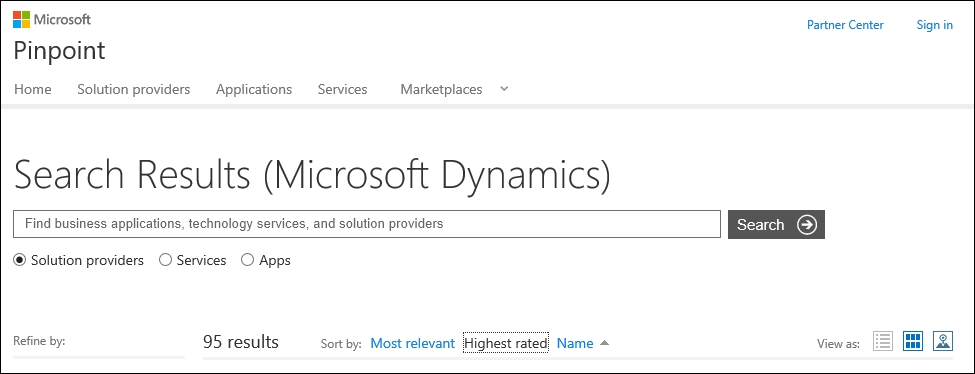
You now have the option to filter your results by Solution providers, Services, or Apps (applications).
In addition, you can further filter your results by distance to a geo-location derived from an address or postal code, as well as other categories as illustrated in the following screenshot:
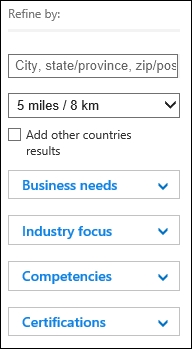
When searching for a solution provider, the results provide a high-level view of the organization, with a logo and a high-level description. The ratings and competencies count are displayed for easy visibility as shown here:

Drilling down into the partner profile page, you can find additional details on the organization, the industry's focus, details on the competencies, as well as a way to connect with the organization. Navigation to additional details, including Reviews and Locations, is available on the profile page.
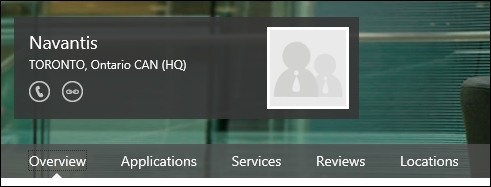
The Dynamics Marketplace is also available, starting with Dynamics CRM 2011, as a part of the organization. A user with necessary permission can navigate to Settings | Dynamics Marketplace.
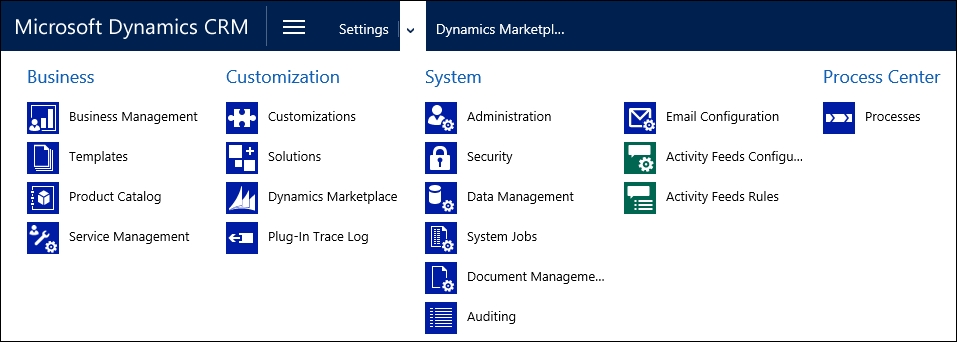
This presents the user with a view by solutions available. Options for sorting and filtering include Popular, Newest, and Featured. Community rating is clearly visible and provides the necessary feedback to consider when evaluating new solutions.
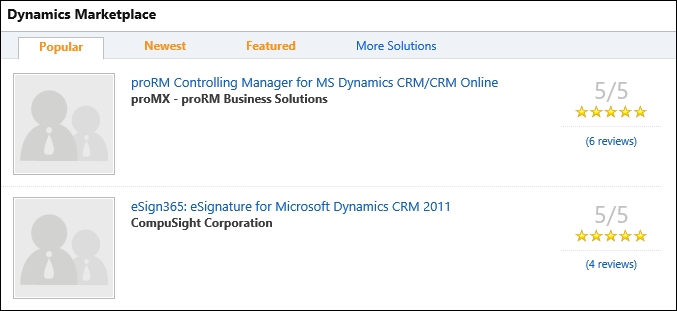
There is a large variety of integration options available when working with Dynamics CRM. In addition, various deployment options offer more or fewer integration features. With CRM Online, you tend to get more integration options into cloud services, whereas the on-premise solution has a limited number of configurable integration options, but can provide more integration using various third-party tools. The base solution comes with the ability to configure integration with the following common services:
SharePoint for document management
Yammer for social features
In addition, you can use specific connectors provided by either Microsoft or other third-party providers for integration with specific solutions.
When the preceding options are not available, you can still integrate with other solutions using a third-party integration tool. This allows real-time integration into legacy systems. Some of the most popular tools used for integration include, but are not limited to:
Kingsway Software (https://www.kingswaysoft.com/)
Scribe (http://www.scribesoft.com/)
BizTalk (http://www.microsoft.com/en-us/server-cloud/products/biztalk/)
Dynamics CRM offers users a variety of options to interact with the system. You can access Dynamics CRM through a browser, with support for all recent versions of the major browsers now. The following browsers and versions are supported:
Internet Explorer versions 10 and above
Edge latest version
Chrome latest version on Windows 7 and above
Firefox latest version on Windows 7 and above
Safari on Mac using the latest publicly released version on OS X 10.8 and above
In addition, a user can interact with the system directly from the very familiar interface of Outlook. The Dynamics CRM connector for Outlook allows users to get access to all the system data and features from within Outlook. In addition, a set of functions built specifically for Outlook allows users to track and interact through e-mails, tasks, and events from within Outlook.
Further to the features provided through the Outlook integration, users of CRM for Outlook have the ability to work offline. Data can be taken offline, work can be done while disconnected, and can be synchronized back into the system when connectivity resumes.
For mobile users, Dynamics CRM can be accessed from mobile devices and tablets. Dynamics CRM provides a standard web-based interface for most mobile devices, as well as specific applications for various platforms including Windows-based tablets, iPads, and Android tablets. With these apps, you can also take a limited sub-set of cached data offline, as well have the ability to create new records and synchronize them back to CRM next time you go online. The quality of these mobile offerings has increased exponentially over the last few versions, and new features are being added with each new release.
In addition, third-party providers have also built mobile solutions for Dynamics CRM. A quick search in the application markets for each platform will reveal several options for each platform.



